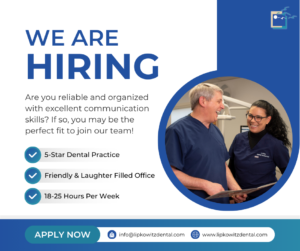Dr. Rob. So many of your patients have commented on how impressed they are by your new patient exam. They find it refreshing that you get to know them, do a thorough dental exam, and also set expectations for their Dental Health.
Now, what would you say is unique about your first patient visit and what would you say to a first patient as to what they can expect on that first time they meet with you?
So I think there are a few things that are unique about my examination. The first thing is that I do spend quite a few minutes just talking to a person. Finding out who they are, what their past experiences have been like, health history, things like that. But also finding out what their goals are is one of the cornerstones of the big dental examination.
Another thing that’s unique about my dental exam is that I do a full systems evaluation. So instead of just looking at your mouth one tooth at a time, I look at it as a big picture because everything is interrelated.
So my exam is designed to do two things. One is to give people a really good idea about how healthy they are, and the second is, once we’re done with the exam there’s going to be three critical areas that I’m going to assign some risk factors.
My goal is to help people keep their teeth for their lifetime. So I like to help them get healthy, but then over time reduce these risks down as close to zero as possible so people get to keep their teeth.
What are the next steps?
Now, as far as what they can expect during their new patient exam after we’re finished in my office, we’ll go back into the operatory and I’ll start doing my examination. The first thing we do is an oral cancer screening. We’re looking for any lumps or bumps are oddities that might be potentially dangerous.
Then I’m going to look at their teeth and the dental restorations carefully to make sure that they’re healthy. After that, we’ll examine their gums and the bone that supports their teeth. The last thing I look for is the chewing system; how the teeth, muscles, and joints all work together mechanically. Like any other mechanical system, if things are in harmony they last a long time without wearing themselves out. But if things are not in a good alignment, things will wear out early and prematurely.
After I’m done with that, I’ll spend a few minutes reviewing everything that we found today, and then we’ll take some necessary x-rays. After the x-rays are taken, the visit is done!
Do patients usually need a follow-up visit?
If a person’s problems are complex, they’ll come back for another visit where the patient and I will sit together and come up with a plan that makes sense for them. We’ll make both a short-term plan to manage acute disease, gum disease or tooth decay, maybe a broken tooth, whatever that happens to be, then the long-term goals also. Frequently, people have long-term goals but the first thing you always want to make sure of is that they’re healthy first before we then move ahead and start building a beautiful smile or stabilizing their bite.
So if their problems are not complex, then I’ll probably just sit down with them for a few minutes and talk to them about the few problems that they have and the things that we can do to fix those problems. It’s important to me that my patients and I create a partnership because there’s a lot of different ways to do things and I want people to feel comfortable that they have a role in how their plans play out. So, at that point, we might finish up with just a simple plan and their next visit would typically be a cleaning.





